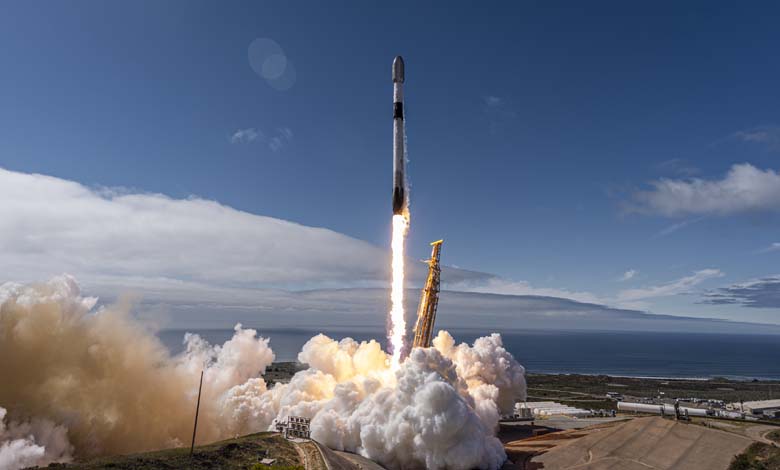SpaceX Launches 28 New Starlink Satellites into Space

On a historic day for space exploration, the American aerospace company SpaceX successfully launched 28 new satellites into space, adding another crucial layer to its ever-growing Starlink constellation. The launch took place today, further cementing SpaceX’s role as a leader in the realm of satellite technology and space infrastructure. Starlink, SpaceX’s ambitious project to deliver fast and reliable internet access to underserved and remote areas across the globe, is making significant strides with each successful mission.
The Falcon 9 rocket, which has become a hallmark of SpaceX’s reusability and technological prowess, lifted off from the iconic Cape Canaveral Air Force Station in Florida. The Falcon 9 carried with it 28 Starlink satellites, a crucial part of the ongoing effort to create a global network of low Earth orbit (LEO) satellites. This satellite network is designed to provide high-speed, low-latency internet to even the most remote and hard-to-reach areas on Earth. Approximately 60 minutes after launch, the spacecraft successfully placed the new batch of satellites into their designated low Earth orbit, marking another key milestone in the expansion of the Starlink constellation.
The Falcon 9: A Testament to SpaceX’s Mastery of Reusable Rockets
As part of SpaceX’s continued commitment to reducing the cost of space missions and making space exploration more sustainable, the first stage of the Falcon 9 rocket performed a successful controlled landing after completing its primary mission. Just about eight minutes after launch, the rocket’s first stage booster executed a flawless return and landed on a SpaceX drone ship stationed in the Atlantic Ocean. This achievement is particularly noteworthy because today’s mission marked the 17th launch and landing of this particular booster, which had already completed ten previous Starlink missions.
The successful landing of the Falcon 9’s first stage booster highlights SpaceX’s ability to recycle rockets, significantly reducing the cost of each mission. This reusability is a groundbreaking feature that sets SpaceX apart from traditional space agencies and allows for more frequent launches, making space exploration more cost-effective and accessible. In fact, the ability to reuse rocket stages has been a cornerstone of SpaceX‘s efforts to disrupt the space industry and to drive down the costs of space travel.
-
Space junk found in Australia suspected to be from SpaceX
-
SpaceX fires employees who criticize Elon Musk
The landing itself occurred aboard one of SpaceX‘s autonomous drone ships, located in the middle of the Atlantic Ocean. These drone ships are equipped with advanced technology that allows them to track and catch the descending booster in the vastness of the ocean. The precise landing is an impressive feat, particularly given the challenging conditions of the ocean and the high speeds involved in the rocket’s descent.
The Growing Starlink Constellation: Connecting the World Like Never Before
Today’s launch is a testament to SpaceX’s ambitious vision for the future of global connectivity. Starlink is currently the largest satellite constellation ever assembled, with approximately 7,100 active spacecraft orbiting the Earth. This massive network of satellites is designed to deliver broadband internet service to areas that have traditionally been underserved or completely lacking in reliable internet access.
-
Stranded American Astronauts at the International Space Station Set to Return to Earth After Nine Months
-
Sunrise on the Moon: A Stunning Shot by the “Blue Ghost” Lander
One of the key benefits of Starlink is its ability to provide high-speed internet to regions where traditional ground-based infrastructure is either too costly or logistically impossible to implement. These areas include remote rural locations, islands, and places affected by natural disasters. Starlink’s low Earth orbit (LEO) satellites provide broadband speeds that are comparable to or even better than traditional internet services, with significantly lower latency due to their closer proximity to the Earth’s surface compared to geostationary satellites.
As Starlink continues to expand, SpaceX is working toward a global network that can serve millions of people in regions where connectivity was previously out of reach. This project has the potential to revolutionize internet access on a global scale, making it possible for individuals and businesses in even the most remote areas to connect to the world in ways that were once considered impossible. The expansion of Starlink will also have a profound impact on education, healthcare, and economic opportunities, particularly in regions where access to modern communication tools is limited.
-
The Secret Behind Mars’ Red Color… Is Water the Cause?
-
Discovery of Billion-Year-Old Seashores on Mars
SpaceX’s Long-Term Vision for Space and Satellite Technology
The successful launch of 28 new Starlink satellites is just one step in SpaceX’s broader vision for the future of space and satellite technology. Beyond providing internet connectivity, Starlink represents a fundamental shift in how we think about space-based infrastructure. With its constellation of satellites, SpaceX is laying the groundwork for a wide range of applications, from global communication networks to future space exploration missions.
Starlink’s potential also extends beyond Earth. As SpaceX continues to push the boundaries of space exploration, the technology behind Starlink could play a crucial role in missions to the Moon, Mars, and beyond. Future space explorers will need reliable, high-speed communications to support their operations, and Starlink could provide the necessary infrastructure for these missions.
Elon Musk, the CEO of SpaceX, has been vocal about his long-term goals of enabling human life on other planets, particularly Mars. The ability to provide reliable, low-latency internet on Mars will be essential for any potential human colonization efforts. Starlink’s technology is a crucial part of this vision, as it could help provide communication links between Earth and future Mars colonies. By refining satellite technology and expanding the constellation, SpaceX is setting the stage for a future where humans can live and work beyond our planet.
SpaceX and the Future of Space-Based Internet Services
Looking forward, the scope of SpaceX’s Starlink project is nothing short of extraordinary. While the 28 satellites launched today will bolster the existing constellation, SpaceX’s long-term goal is to have over 12,000 satellites orbiting the Earth, with future plans possibly involving up to 42,000 satellites in orbit. This would create a near-global coverage network capable of providing fast and reliable internet to virtually every corner of the planet.
-
How Did Elon Musk Cause a Rift Within the British Royal Society?
-
New Study Reveals Shocking Information about Space Travel
As the Starlink network expands, SpaceX is continuously optimizing the technology behind its satellites. This includes refining the design and efficiency of the spacecraft themselves, as well as improving the ground stations that support the network. The company is also working on minimizing the impact of its satellites on space debris, as the rapid expansion of satellite constellations has raised concerns about the potential for collisions and the creation of debris that could pose a hazard to other spacecraft.
Furthermore, Starlink’s commercial rollout is expected to increase dramatically in the coming years. While the service is currently available in select areas around the world, it is expected to reach global availability in the near future. This expansion will bring high-speed internet to underserved regions and provide a viable alternative to traditional internet service providers.
-
The First Wooden Satellite in the World Launched from Japan
-
After hours of returning… NASA announces astronaut transferred to hospital
Starlink’s Impact on Global Connectivity and Society
In addition to improving internet access in rural and remote areas, Starlink could have a profound impact on various industries, including healthcare, education, and disaster relief. In regions with limited infrastructure, Starlink can provide crucial access to telemedicine services, enabling patients to consult with doctors and receive medical advice without the need to travel long distances. In education, Starlink can help bridge the digital divide by providing students in remote areas with access to online learning resources, potentially transforming their educational opportunities.
During natural disasters, Starlink’s satellite network can also provide emergency responders with vital communications capabilities. In areas where traditional communication infrastructure has been destroyed, Starlink’s satellites can be quickly deployed to restore connectivity, enabling rescue operations and coordination efforts.
-
Something resembling a human face on Mars… What does it mean?
-
The U.S. Approves the Resumption of Falcon 9 Operations
As the network expands, SpaceX aims to deliver on its promise of providing affordable and fast internet to millions of people across the globe. In this way, Starlink represents not just a technological achievement, but a potential lifeline for people in some of the most underserved areas of the world.
Conclusion: A Vision of the Future
Today’s successful launch of 28 new Starlink satellites is another significant step toward realizing the vision of a world where everyone, everywhere, has access to fast, reliable internet. With its cutting-edge technology, sustainable approach to space travel, and bold ambition, SpaceX is helping to pave the way for a more connected, technologically advanced future. As the Starlink constellation continues to grow, the possibilities for improving global communication, bridging digital divides, and enabling space exploration become ever more promising. SpaceX’s achievements are not just changing the way we think about space—they are changing the way we think about our future on Earth and beyond.












